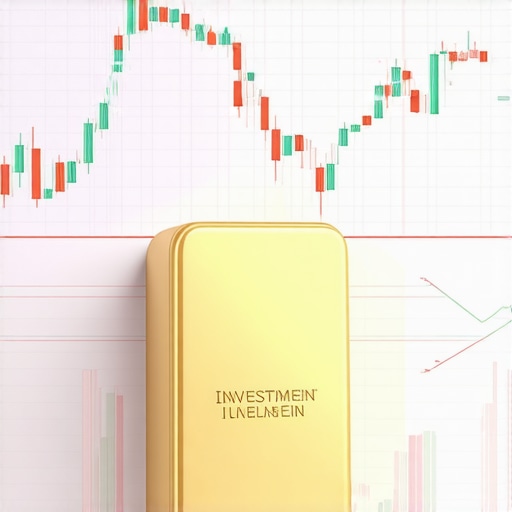Unlocking the Power of Diversification: Why Gold and Stocks Are Essential for 2025 Portfolio Resilience
In the ever-evolving landscape of investment management, understanding how to effectively diversify remains a cornerstone of risk mitigation and value enhancement. As global markets face unprecedented dynamics—ranging from geopolitical tensions to technological disruptions—investors must leverage deep expertise to balance traditional and alternative assets. This article explores the nuanced interplay of gold and stocks, emphasizing their roles in constructing resilient portfolios for 2025 and beyond.
The Strategic Rationale for Combining Gold and Equities in Modern Portfolios
Gold, historically revered as a hedge against inflation and economic downturns, offers intrinsic value and liquidity that complement equities’ growth potential. While stocks provide exposure to corporate earnings and innovation, they are susceptible to market volatility and sector-specific risks. Incorporating gold enhances diversification by negatively correlating with equities during economic stress, thus smoothing portfolio performance. This strategic synergy is underpinned by empirical research, such as the study published in the Journal of Investing, which confirms gold’s role as a stabilizer during turbulent periods.
Expert Insights into the Evolving Dynamics of Gold and Stock Markets
Recent market analysis indicates that central banks’ gold purchase policies significantly influence gold prices, as detailed in this comprehensive review. Simultaneously, technological advancements are transforming stock valuations, especially within emerging sectors like renewable energy and artificial intelligence. Investors must assess these trends through a sophisticated lens, employing quantitative models that incorporate supply-demand shifts, monetary policy trajectories, and geopolitical factors.
How can investors optimize the timing of gold and stock allocations to maximize portfolio resilience in 2025?
This question reflects a core concern among high-net-worth individuals and institutional investors. Effective timing involves monitoring macroeconomic indicators, such as inflation rates, interest rate trajectories, and geopolitical developments. Technical analysis tools, combined with fundamental insights, enable strategic rebalancing that captures opportunities and mitigates risks.
Implementing a Multi-Layered Diversification Strategy
Beyond simple allocation, diversification should encompass various asset classes, including gold ETFs, mining stocks, and physical bullion, as explored in this guide. An expert approach involves dynamic rebalancing, scenario analysis, and stress testing portfolios against economic shocks. The integration of these methodologies ensures that the portfolio not only withstands adverse conditions but also capitalizes on emerging opportunities.
Engagement and Knowledge Sharing: A Call to Action
To refine investment strategies further, professionals are encouraged to contribute insights on evolving gold and stock market interactions. Exploring case studies, sharing quantitative models, and debating policy impacts can foster a community of informed investors committed to advanced diversification techniques.
Harnessing the Power of Dynamic Asset Allocation in Uncertain Times
As we delve deeper into the intricacies of portfolio diversification, the importance of dynamic asset allocation becomes paramount. Unlike static models, dynamic strategies adjust over time based on evolving market conditions, economic indicators, and geopolitical shifts. This approach is especially relevant in 2025, where unpredictable global events can swiftly alter asset valuations. Experts recommend integrating real-time data analytics and machine learning models to fine-tune allocations between gold and equities, ensuring resilience and growth. For a comprehensive understanding of these techniques, explore this in-depth analysis.
Challenging Assumptions: Is Gold Still the Ultimate Safe Haven in 2025?
Many investors operate under the assumption that gold remains the definitive safe haven during economic crises. However, recent research indicates that the relationship between gold and other assets is more nuanced, especially with the rise of digital assets and alternative investments. For example, some studies suggest that during certain geopolitical upheavals, assets like cryptocurrencies may outperform traditional gold. A nuanced understanding of the evolving landscape can be gained from the work published in the Gold Market Analysis 2025 report. This prompts investors to diversify beyond conventional gold holdings, considering innovative instruments aligned with current market dynamics.
How can institutional investors leverage emerging data analytics to optimize gold and stock portfolios amidst volatility?
This question challenges traditional investment paradigms and invites exploration of cutting-edge analytical tools. Incorporating big data, sentiment analysis, and machine learning into decision-making processes allows for more precise timing and allocation adjustments. Such techniques help identify subtle market signals that precede major shifts, providing a competitive edge. For practical insights, see this guide on advanced trading techniques.
Integrating Sustainable and Ethical Investing in Gold and Equity Portfolios
With increasing emphasis on environmental, social, and governance (ESG) criteria, investors in 2025 are seeking to align their portfolios with sustainable principles. Gold mining companies are adopting greener practices, which can influence their valuations and attractiveness as investments. Simultaneously, ESG-focused stocks are gaining prominence, creating new opportunities and risks. Incorporating ESG metrics into asset selection processes enhances portfolio resilience by aligning with global trends and investor sentiment. For a practical approach, review this resource on sustainable gold investments.
Engage and Contribute: Share Your Insights on Future Gold and Stock Strategies
To foster a community of forward-thinking investors, we invite you to share your perspectives on the evolving relationship between gold and stocks in 2025. What innovative strategies are you exploring to optimize portfolio resilience? How are emerging technologies influencing your investment decisions? Your insights can help shape best practices and inspire others to adapt dynamically in an uncertain global economy. Join the conversation by commenting below or sharing this article with fellow investors!
Harnessing Quantitative Models for Precise Gold and Equity Allocation Timing
As investors seek to refine their portfolio resilience for 2025, leveraging sophisticated quantitative models becomes paramount. These models integrate macroeconomic indicators, market sentiment, and technical signals to predict optimal entry and exit points for gold and stocks. For instance, machine learning algorithms trained on historical data can identify subtle patterns preceding market shifts, offering a competitive edge. According to a study published in the Journal of Financial Data Science (2022), such models significantly enhance timing accuracy, reducing drawdowns and improving risk-adjusted returns.
The Role of Behavioral Finance in Shaping Investment Decisions During Volatility
Understanding investor psychology is often overlooked yet critically important during turbulent periods. Behavioral biases such as herding, loss aversion, and overconfidence can distort market perceptions, leading to suboptimal decisions. Advanced investors employ behavioral analytics tools to gauge market sentiment and anticipate collective reactions, thereby timing their gold and stock allocations more effectively. Incorporating these insights can help mitigate emotional biases, fostering disciplined rebalancing strategies that align with long-term objectives.
Integrating Blockchain and Digital Assets into Traditional Portfolio Models
The rise of digital assets introduces new complexities and opportunities. While cryptocurrencies like Bitcoin and Ethereum are not traditional safe havens, their low correlation during certain market conditions suggests potential as alternative hedges. Blockchain technology also facilitates transparent and efficient trading, settlement, and custody solutions for gold-backed tokens and digital commodities. Experts like those at the Crypto Investment Review advocate for integrating these assets within diversified portfolios, emphasizing rigorous due diligence and risk management frameworks.
What are the best practices for managing counterparty and cybersecurity risks when incorporating digital assets into gold and stock portfolios?
This nuanced question addresses the emerging challenges of digital asset security and trust. Best practices include employing cold storage solutions, multi-signature wallets, and engaging with regulated exchanges. Additionally, continuous cybersecurity audits and adherence to evolving compliance standards are essential. Expert guidance from cybersecurity firms specializing in financial assets can provide tailored safeguards, ensuring digital inclusion enhances rather than jeopardizes portfolio resilience.
Adopting a Holistic Macro-Strategic Perspective for 2025
Successful diversification in 2025 demands a macro-strategic framework that synthesizes geopolitical analysis, monetary policy outlooks, and technological innovations. Investors should employ scenario planning and stress testing to evaluate portfolio performance under various global stress scenarios, including inflation shocks, currency fluctuations, and geopolitical conflicts. Resources like the Global Macro Strategy Hub provide comprehensive insights and forecasting tools to support such rigorous analysis.
Join the Vanguard of Forward-Thinking Investors
To stay ahead in the evolving landscape of asset management, engagement with expert communities is vital. Share your innovative approaches, learn from peer-reviewed case studies, and contribute to the collective knowledge pool. By fostering collaboration, investors can develop more resilient, adaptive strategies that harness technological advancements and behavioral insights, ensuring robust performance amidst uncertainty.
Harnessing Quantitative and Behavioral Insights for Precision Asset Allocation
As we navigate the complexities of 2025’s financial landscape, integrating advanced quantitative models with behavioral finance principles becomes crucial for optimizing gold and stock allocations. Machine learning algorithms, trained on vast datasets encompassing macroeconomic indicators, geopolitical events, and market sentiment, enable investors to predict optimal rebalancing points with unprecedented accuracy. Complementarily, understanding investor psychology through sentiment analysis tools helps mitigate biases like herding and overconfidence, leading to more disciplined decision-making during volatile periods.
Innovative Use of Blockchain and Digital Assets to Enhance Diversification
The proliferation of blockchain technology offers new avenues for diversification, especially with gold-backed tokens and digital commodities. These assets often exhibit low correlation with traditional stocks and physical gold, providing unique hedging opportunities. However, integrating cryptocurrencies and digital assets into portfolios necessitates rigorous cybersecurity measures and risk management protocols. Experts recommend employing cold storage, multi-signature wallets, and continuous cybersecurity audits to shield digital holdings from evolving cyber threats, thereby maintaining portfolio integrity in digital ecosystems.
What Are the Cutting-Edge Tools for Managing Counterparty Risks in Digital Asset Integration?
This question addresses the critical need for robust security frameworks. Best practices include partnering with regulated exchanges, utilizing multi-layered authentication processes, and implementing real-time transaction monitoring systems. Additionally, engaging with cybersecurity firms specializing in financial assets can provide tailored safeguards, ensuring that the integration of digital assets enhances overall portfolio resilience rather than exposing it to new vulnerabilities.
Strategic Scenario Planning: Preparing for Global Shocks and Technological Disruptions
Employing macro-strategic scenario planning enables investors to test portfolio robustness under various stress scenarios, including inflation surges, geopolitical conflicts, and technological upheavals. Resources such as the Global Macro Strategy Hub offer sophisticated forecasting tools that facilitate comprehensive stress testing. This proactive approach ensures that portfolios are not only resilient but also positioned to capitalize on emerging opportunities amid uncertainty.
Engage with the Future of Asset Management: Share Your Expertise and Insights
To foster a vibrant community of forward-thinking investors, we invite you to contribute your innovative strategies and insights. How are you leveraging emerging technologies, behavioral analytics, and macroeconomic forecasts to optimize your gold and stock holdings? Your expertise can inspire others to adopt more resilient and adaptive investment practices, shaping the future landscape of portfolio management in 2025 and beyond.
Expert Insights & Advanced Considerations
1. Diversification with Alternative Assets Enhances Resilience
Integrating assets like gold-backed tokens and digital currencies can diversify portfolio risks beyond traditional stocks and physical gold, leveraging low correlations and emerging markets.
2. Behavioral Analytics as a Strategic Tool
Utilizing advanced behavioral finance tools enables investors to anticipate market sentiment shifts, reducing emotional biases and optimizing timing in volatile environments.
3. Macro-Scenario Planning for Future Shocks
Implementing comprehensive scenario analysis, including geopolitical and technological disruptions, ensures portfolio robustness and readiness for unforeseen global events.
4. Embracing Blockchain for Transparency and Security
Incorporating blockchain technology enhances transaction security and transparency, especially when managing gold-backed digital assets, while mitigating cybersecurity risks.
5. Leveraging Quantitative Models with AI
Applying machine learning algorithms trained on macroeconomic and market data enables precise rebalancing strategies, maximizing resilience amid market uncertainties.
Curated Expert Resources
- Global Macro Strategy Hub: Offers in-depth analysis and forecasting models for macroeconomic scenario planning, essential for strategic asset allocation.
- Journal of Financial Data Science: Publishes cutting-edge research on AI-driven quantitative models that enhance investment timing and risk management.
- Crypto Investment Review: Provides expert insights into integrating digital assets and blockchain innovations within traditional investment portfolios.
- Buying Gold Now: A comprehensive resource for understanding gold market trends, supply-demand dynamics, and innovative investment instruments.
Final Expert Perspective
In the landscape of 2025 investments, mastering the interplay between gold, stocks, and emerging digital assets is paramount for building resilient portfolios. Leveraging advanced analytical tools, behavioral insights, and macro-scenario planning empowers investors to navigate volatility with confidence. As experts, we encourage continuous learning and adaptation—exploring authoritative resources like the Future of Gold Market 2025 and engaging with innovative strategies. Your proactive approach today shapes your financial resilience tomorrow—remain informed, stay agile, and contribute your expertise to this evolving field.









